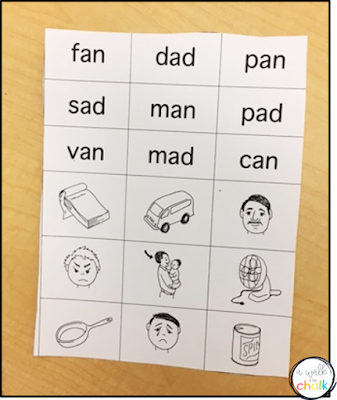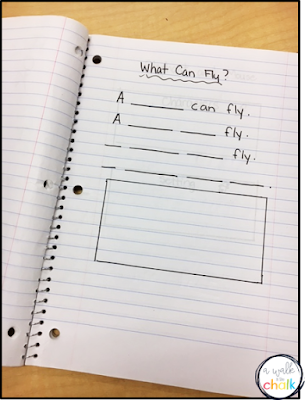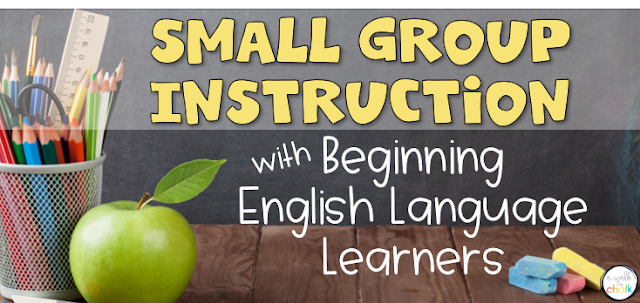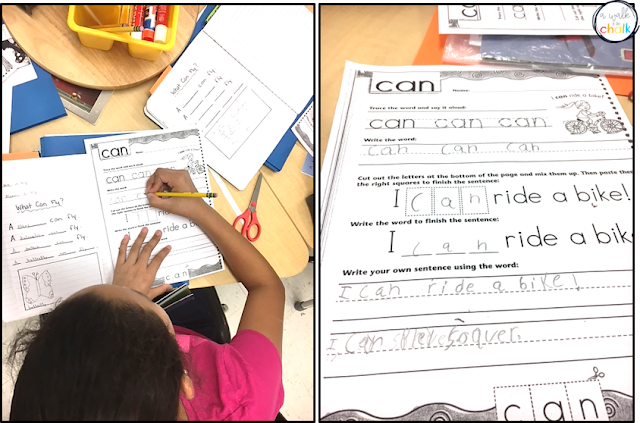As an ESL teacher, I often hear from classroom
teachers that they don’t always know where to start when it comes to working with beginning English language learners (ELLs), or newcomers, in small group instruction. In this post I’ll share a typical
“guided reading” lesson that I would give to my beginning ELLs, as well as a glance of at what a typical week would look like.
first thing I do before I start instructing my newcomers is, I assess what they
already know. First, I see if they have literacy skills in their
native language…can they read and write? Then, I see if they
know alphabet letter names and sounds. Next, I assess their reading level. Since they don’t have English literacy skills yet, their reading level typically
starts at level “A” (emergent). I can say that most students do
have some literacy skills in their home language, and often times, many know some
letter names and sounds. So now I’ve got my starting point!
Step 1 – Choose an appropriate book. I carefully select books that have relevant vocabulary. For the most part, my main focus is to build their vocabulary. The literacy skills in their native language will transfer to their new language, however, they
have an extremely limited vocabulary, so… vocabulary, vocabulary, vocabulary!
I chose this book because I wanted to teach my students the
word “big.” It’s also about animals, and I know that most kids are interested in reading about animals! I used gestures to SHOW them what “big” means.
Step 2 – Preview the book. Point
to and say each animal’s name and have the students repeat the names back
to you, keeping in mind to speak clearly and to enunciate the sounds in each word. It’s important for them to hear how to pronounce the names.
A side thought…Think about “A” level books… they are not created with English language learners in mind. “A” level books have repeated sentences, which are GREAT, but they also have very specific vocabulary that students are expected to decode using picture cues. In the book my students read last week, the repeated sentence was, “We go to the _____.” The pictures show the family in different locations like the pool, park, library, soccer game, etc. In one picture the family is standing in front of a large fish tank. If I asked English only students where the family is, some might say a fish store or they might even guess aquarium, depending on their background knowledge. Then they’d cross check their thinking with the word and see that it begins with the letter “a” and hopefully they’d say, “It’s an aquarium!” But our newcomers don’t know what a big fish tank place is called in English, so it’s important for us to support our students by saying the names of each vocabulary word.
Step 3 – Choral reading! Newcomers feel more comfortable in a choral reading setting. They need help pronouncing the words. They need to hear
YOU pronounce the words. Choral reading helps to keep anxiety levels low.
(In a few weeks, the choral reading decreases and I will start focusing on
decoding.)
animal and see if they can remember the name. Perhaps make a matching activity with animal pictures and names. Support as needed. Encourage
a LOT!
Step 5 – I always provide a guided
writing activity based off of the book we just read. I use sentence frames
to support their thinking and writing. Sometimes I create my own, like the
picture below, and other times I’ll use a graphic organizer as a follow up
activity. On this day I wanted them to understand the meaning of “big,” so their writing supported this goal.
I know that my newcomers don’t understand every word in the book, and that’s OK! They are being exposed to new words and ideas in a repeating format. I want them to get used to the structure of our lessons so that they know what’s expected.
So, here is what a typical week of small group work entails for my newcomers. Knowing what the focus is each day helps me to zone in on their learning goals. The variety keeps it fun and interesting, yet it’s consistent so they know what’s expected.
As you can see, on Tuesdays I include direct vocabulary instruction, either using the vocabulary from the book, like the animals, monthly themed vocabulary, or content area vocabulary.
 |
| October Themed Vocabulary (along with sight words and phonics review) |
One vocabulary activity I have my students do is called the K.I.M. Strategy. In their notebook they write
the key word (K), important information (I), sketch a memory clue (M) and write a sentence
(S). For my newcomers, I leave out the (I) portion. They are not ready for adding
“information.” Right now the goal is for them to learn the names of
things and simple sentence structure. My higher ELLS definitely include all components of the K.I.M.
Strategy in their notebooks.
On Thursdays, I focus on building sight words. When teaching sight words, it’s important to teach
them in context. Your beginning ELs need context
in order to make meaning of the words. I pull a sight word from our books and I include an extension activity with that word. (A link to this resource is provided at the bottom of this post.)
I do teach sight words throughout the week, but on Thursdays we always have an extension activity for one of them.
As an “exit ticket” I have them
orally use the sight word. Today, I asked each student,
“What can you do?” And they responded with “I can
_____.” Then they get a high five, a sticker (big kids like stickers too!), or some encouraging praise.
I also include Word Study activities in my small group work. I like using the sorts from Words Their Way. Each Monday they receive a new spelling pattern. Remember, I assessed my students to see what they already knew. Most already knew initial sounds, so I started them with word families. If they did not know initial sounds, I would’ve started there. I do have one student in this group who does not know many initials sounds, so I spend a little extra focus with him on initial sounds.
 |
| This resource is from “Words Their Way.” |
My newcomers use this activity to learn spelling patterns AND vocabulary. They are introduced to their new word list on Mondays, then they have independent activities to do with their word list throughout the week in their gen ed classrooms. (It’s so important to set newcomers up with meaningful activities that they can work on independently during Reader’s Workshop.) Below is their Word Study Activities list. It gets glued into their Reading Notebook. On Tuesdays, Wednesdays and Thursdays they work on their independent activities. Friday is Word Study Quiz day!
 |
| FREEBIE – Click Here |
And that’s what small group instruction looks like with my newcomers.
To recap, assess what students can do to evaluate your starting point. Focus on building vocabulary, sight words in context, word spelling patterns and choral reading to start. My guided reading lessons usually looks like… preview the book, front load main vocabulary, choral read, and end with a guided writing activity with sentence frames.
Here’s a TIP: Many times I make my own guided
writing activity based on what I want the students to learn from the
book. I’ll write the activity in my notebook, make copies, cut them to size,
then have students glue it into their notebook. Keep this
notebook! You may get a newcomer next year, and when you do, many of
your guided writing activities will already be made. You’ll just need to find
the book that goes with the activity.
 |
| My notebook where I write out the guided writing activities. |
resources and often times the classroom teacher is the only one
providing instruction. Knowing where to start with beginning English learners is probably the biggest challenge. I hope that this post gives you some ideas
about where to start and what to focus on with your new students.
To read more about the K.I.M. Strategy, click here.
Affiliate links below for Sight Words and Word Study.














